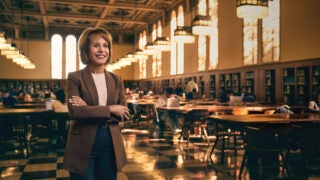Trojan Pride
Each fall, a sense of anticipation swells at leading universities around the world, as a select few of their most preeminent faculty hope for a certain phone call. For those in the United States, the call comes in the middle of the night, from a polite stranger in Sweden, one whose accent offers assurance that the call is real. That moment is life-changing and career-defining, as it brings the extraordinary news of a Nobel Prize.
This year the call came to USC Distinguished Professor Arieh Warshel of our USC Dornsife College of Letters, Arts and Sciences. Professor Warshel was awarded the 2013 Nobel Prize in chemistry, along with two esteemed colleagues at other institutions, Harvard’s Martin Karplus and Stanford’s Michael Levitt, with whom he collaborated earlier in his career.
This was a joyful, historic day for USC. Professor Warshel joined USC’s faculty as an assistant professor in 1976, and this prize reflects the university’s longstanding investment in research, especially in science and technology. Professor Warshel has essentially spent his entire career at USC, and our pride is palpable.
Niki and I congratulated Professor Warshel and his family on the morning of the announcement. And when we entered Town & Gown for the press conference, and as media cameras flashed, the crowd burst into sustained applause for our Nobel winner. Affection and admiration filled the room.
When the Royal Swedish Academy of Sciences called at 2 a.m., it was Tamar, Professor Warshel’s wife of 47 years, who answered the phone. Words initially eluded both. “I don’t think he knew what to say to me,” she later recalled. “But I understood right away. You could see the happiness.”
From there congratulatory calls poured in, including one from Israeli Prime Minister Benjamin Netanyahu, who asked Professor Warshel to describe the significance of his work. Professor Warshel’s one-minute explanation was so effective that the prime minister said he would now expect all his advisers to explain everything in the same speedy manner.
Among Nobel laureates in chemistry—a list that dates back to 1901—Professor Warshel and his colleagues are somewhat special, as this year’s award recognizes work that did not involve beakers or Bunsen burners. Instead, they used sophisticated computer modeling to advance our understanding of molecules, pioneering a modern update to plastic balls and sticks.
Beginning in the 1970s, long before computers were commonplace, Professor Warshel and his colleagues created numerical simulations of molecules, which enabled them to examine these particles even more minutely and rigorously. This has dramatically deepened our understanding of complex chemical reactions, such as combustion and photosynthesis, and has significantly improved the design of new drugs.
At USC’s press conference, Professor Warshel charmed everyone with his humor. When asked how he persevered over the decades and maintained his drive and focus, he shrugged and said, “I had nothing else to do.” And when asked how he would spend his third of the $1.2 million prize, he jokingly told reporters to ask his wife.
The Warshels’ daughter, Yael, who is an alumna of USC, sat in the front row, and her presence lent poetic coincidence to the morning. When USC’s Distinguished Professor George Olah won the Nobel Prize in chemistry in 1994, Yael was a reporter for the Daily Trojan, and it was she who photographed him for the story.
Now, 19 years later, Professor Olah was also in the front row, warmly cheering Yael’s father, his venerable colleague, and USC’s newest Nobel laureate.



